There are plenty of changes you can make to your lawn to attract more birds and keep them coming back. You can make improvements like switching from harmful pesticides to more organic pest control methods to avoid poisoning birds, as well as increasing their food supply. You can also save time and money by mowing your lawn less often to encourage a more balanced ecosystem. You can even skimp out on some autumn lawn cleanup by not raking up sections of dead leaves to provide nesting material and encourage natural mulching.
In the springtime, you can combine your love of gardening and birds by selecting native plants, flowers, and fruit trees to grow in your yard. These plants will encourage species to seek out your yard as a refuge and a great food source. Even something as simple as changing your indoor/outdoor cat to just an indoor cat can create a sharp uptick in bird activity by removing a predator. Some of these tasks are quick fixes that only take an afternoon, while others will require years of commitment and care. No matter the timeframe, these are the best ways to make your yard a bird-friendly paradise.
Avoid pesticides to keep from harming the birds
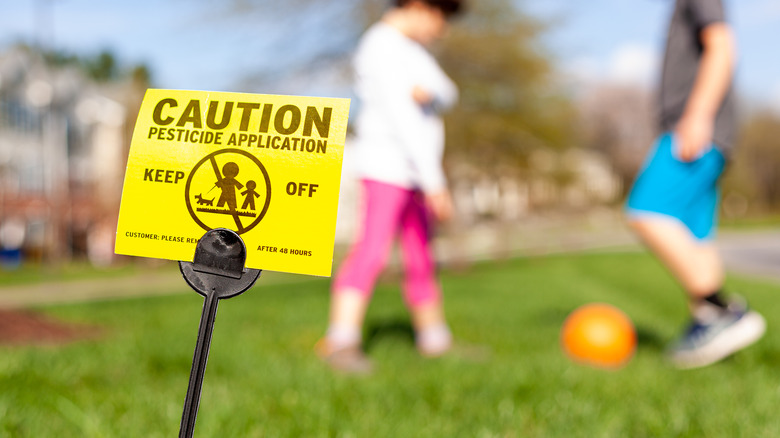
Using pesticides in your yard can seriously harm both the birds and the overall ecosystem, so don’t use them if you want to keep birds happy. Although these chemicals are meant to eliminate pests, they can also directly and indirectly hurt birds. Birds might eat insects that have been exposed to pesticides. They might also consume plants that have been sprayed, which can lead to them getting poisoned and dying. Pesticides also reduce the number of bugs available for birds to eat, which is a big problem because bugs are a crucial part of their diet. This can make it harder for birds to breed successfully because they are hungry or constantly searching for food instead of breeding. This can cause their populations to go down.
Instead of using pesticides, there are many other bird-friendly options to deal with pests in your yard. One good idea is to let ladybugs and lacewings loose since they eat the bugs that bother your garden. You can also garden more organically, using natural materials like neem oil or diatomaceous earth to control pests without hurting wildlife. By choosing these eco-friendly alternatives, you’ll make a better environment in your garden for birds.
Create attractive places with native plants
Most of the birds that visit your yard are native to your area. To have adequate nutrition and shelter for them, you need to provide plants that naturally occur in their environment. This is especially important if you live in a more urban area where the birds might have experienced more significant habitat loss. For example, the blue jay is most often found in the eastern United States. If you live in Illinois, backyard landscaping that mimics the deserts of Arizona won’t make your lawn hospitable to this species. Swap the cacti for oak trees to provide acorns for blue jays to eat for generations to come. The opposite is true if you live in a more arid climate. Birds like the cactus wren and western screech owls need cacti to thrive. By planting the type of plants that naturally occur in your area, you are giving the local bird population a boost (and an open invitation to hang out at your house).
If you are unsure which types of plants will help the birds near you thrive, there are a few easy places to check. Most local botanic gardens, Audubon societies, and gardening clubs will have a full list of the birds native to your area and the kinds of plants they prefer. If not, your state’s state bird, tree, and flower are a great place to begin.
Plant flowers for a sweet treat
Birdimages/Getty Images
Birds love flowers, especially the sweet nectar they provide, which gives them the energy they need. Your yard will become a favorite if you plant plenty of flowering plants. Some birds, like hummingbirds, even have special beaks that are perfect for sipping up nectar. While they are feeding, the birds accidentally move pollen from one flower to another. It gets stuck on their beaks and feathers. By doing this, they are helping to create more flowers through pollination. By planting one round of flowers to attract birds, the animals can help keep your garden going. It’s a win/win situation.
When choosing flowers that birds will love, there are a few things to remember to make your yard bird-friendly. First, choose flowers that are native to your area. These are the flowers that naturally grow there, so birds are already used to them. They provide a delicious, and familiar, food source. The type of native flowers you pick is also important. If you want to attract nectar-feeding birds like hummingbirds, go for tubular or trumpet-shaped blooms. To attract seed-eating birds, sunflowers and coneflowers are a good choice. And it’s a good idea to have a mix of flowers that bloom at different times of the year so birds always have something to eat.
Plant fruit trees to provide snacks for birds (and you!)
Barbara Smits/Shutterstock
Much like native plants and flowers, birds love fruit trees. The fruits and the flowers that precede them are sweet and healthy. They are full of the vitamins and nutrients that birds crave. Fruit trees always have plenty of food because the fruits grow back every year. This means the birds will keep coming back for more. Plus, when birds eat the fruits, they help spread the seeds and grow more of them.
When choosing the type of fruit trees to plant, there are two things to consider. The first is what type of fruit you enjoy. While planting fruit trees to attract birds is great, the amount of work they require means that you should be looking forward to the harvest, too. The second thing to think about is what fruits birds are known to enjoy. The crabapple tree is popular with many different species. The bright, colorful apples are delicious, while its pretty flowers feed birds and bees alike. These trees also don’t grow too large, making them perfect for smaller yards. You might also consider the classic options of apple or pear trees, as it is easy for most people to enjoy any fruits the birds don’t.
Keep grass high to encourage nesting and cultivate food
Tim Graham/Getty Images
Having longer grass in your yard is great for birds and their safety. It gives them a safe place to nest and find food, away from predators. Plus, it helps create a diverse ecosystem of insects and other small critters like worms that birds love to eat. If you want to help birds by having longer grass in your yard, there are a few things you can do that won’t get you a letter from your HOA.
The first thing to do is simply mow less often. Mowing weekly or biweekly is good, but mowing every three weeks is better. In areas that aren’t used (or seen!) as often, like the backyard, consider going even longer between mows. If this sounds unsightly to you, or you know your HOA would not let you get away with this, try designating a few wildlife zones instead. These areas, perhaps in the rear corners of your yard, are places where the grass can grow freely without being cut and won’t disrupt your daily routine. The longer the grass, the more food for birds because of insects and grass seeds. The more food for birds, the longer they will stick around.
Leave bare spots for dust baths
Weisschr/Getty Images
Dust bathing is like a spa day for birds. Many species roll around in dirt or sand to get rid of any excess oils, dirt, or bugs that might be hanging out on their feathers. When they clean their feathers, it keeps birds healthy and makes it easier for them to fly. Some birds even use dust baths to regulate their body temperatures. The dust particles they rub into their feathers create a layer that helps them either cool down or warm up, depending on the weather. For some birds, it’s also social. So if you want to make your yard a place birds love to be, you should have one available.
First, choose a good spot that’s sunny and has soil that drains well. Birds like areas with loose, dry dirt or sand for their dust baths, so pick somewhere you can clear out any grass or plants to make a bare patch of earth. Make it easier for the birds to scratch and dig by loosening up the soil with a shovel or garden tool. If your soil is too heavy or does not have the right texture, you might want to mix in some play sand or fine, dry topsoil. Birds usually prefer dust bath areas near cover, like shrubs or trees, so they can quickly hide if needed. Once your dust bath area is set up, keep an eye on it to see which birds come by, and if the soil gets too packed or wet, just refresh it.
Minimize raking so there are foraging materials
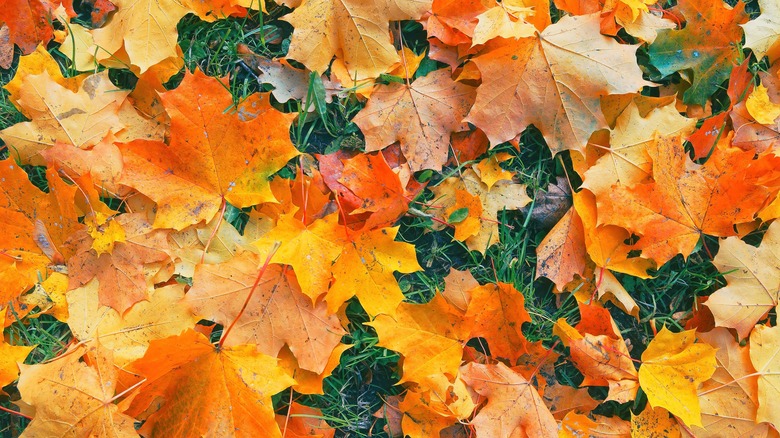
sun ok/Shutterstock
Although you might prefer a yard free from autumn debris, not raking too much is good for birds. It keeps the fallen leaves and natural ground cover intact, which is important for the insects that birds eat to thrive, like caterpillars. The leaves also protect birds that build their nests on the ground from predators.
To fix the effects of over-raking, it’s important to take a more hands-off approach. Instead of raking every leaf, let them naturally pile up in your yard, especially in less visible or less used areas. This way, these untouched leaf piles create little ecosystems that give insects a place to live and search for food. They also act like free mulch, keeping weeds from popping up everywhere and providing nutrients to the soil as they decompose. Of course, you don’t have to leave your entire yard covered in debris. It is possible to create small pockets for birds, like in your flowerbeds or the back edges of your yard. This way, you have a clean-looking lawn that keeps both the HOA and the local bird population happy.
Create a dog kennel or cat run to prevent attacks
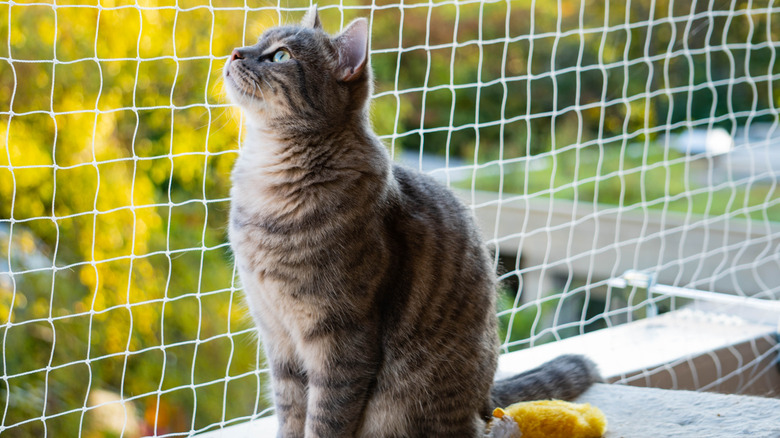
Simona Weber/Getty Images
Pets, especially outdoor cats, can be quite a threat to birds. Cats are natural hunters and their high prey drive often ends with birds becoming lunch. Even if cats are full, they will still hunt because it is their nature. Dogs are also disruptive to birds through barking, chasing, or destroying nests. When our pets invade their outdoor space, birds get stressed out and struggle to breed successfully. They also become easier targets for other predators. To make your yard a good place for birds to be, it’s important to responsibly handle your pets.
If you want to give your pets some outdoor fun while keeping the birds safe, consider building a catio or dog run. A catio is a little screened-in area for your cats where they can enjoy the outdoors without going after birds. It’s a safe spot for them to get some fresh air, sunshine, and playtime, while the birds can relax knowing they’re out of harm’s way. And for dogs, a well-fenced dog run can keep them from chasing and bothering birds in your yard. These enclosed spaces don’t just protect the local bird population, they also promote a friendly and responsible relationship between pets and wildlife, making the outdoors a better place for everyone.
Provide birdhouses for nesting opportunities
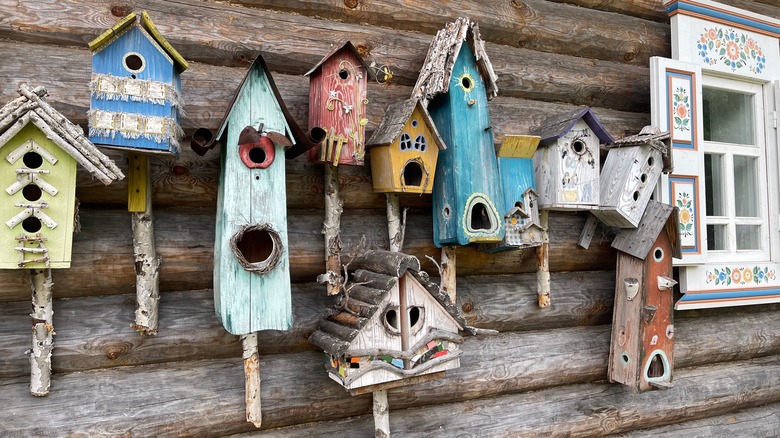
luckyelephant/Shutterstock
Most bird species love birdhouses, so having a few in your yard makes it an attractive place for them to hang out. These little homes keep them safe from bad weather and predators, and they provide a nice, cozy place to raise their chicks. Unfortunately, some birds can be picky and do not want to use your birdhouses. Luckily, most of these issues are easy to fix and can be completed in just a few hours.
Some things that might be keeping birds away are holes that are the wrong size, a lack of nesting material, predators on the loose, or even a bad smell. For example, if the hole is too small for a bird to fit through, it will not be able to nest. Consider the type of bird you want to attract (is it a tiny sparrow or a larger mourning dove?) and adjust the entrances accordingly. Take a look around your yard and see if there is nesting material available — if there isn’t, no matter how many birdhouses you put out, they will stay empty. The same goes for where they are located. Are squirrels already living inside? Is it too close to the ground, making the birds feel unsafe? It might also stink like chemicals or other birds, so consider giving it a good wash after purchasing it and at least once a year after that.
Install birdbaths for a cool dip
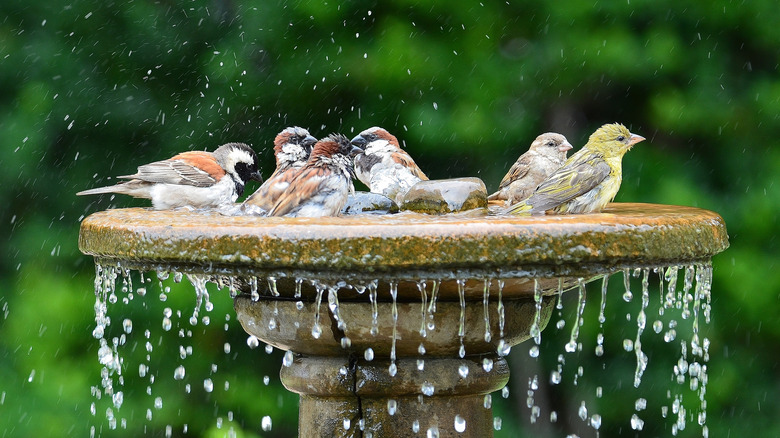
Evelyn Joubert/Shutterstock
Birds love birdbaths as they are an accessible water source, particularly during hot and dry weather. They also serve as essential spa centers for our feathered friends. Much like a dust bath, a water bath is a grooming ritual to keep plumage clean, soft, and in optimal condition, necessary for both insulation and flight. Baths are also social for birds, allowing them to cool off and enjoy time with their flocks.
When installing a birdbath in your yard, location matters. Place the birdbath under a tree or near some bushes so the birds have a place to flit off to if they feel like they are in danger. You should also make sure the bath is in a spot that isn’t in direct sunlight all day so the water doesn’t get too hot. Ensure that the bath stable so the birds feel comfortable using it. A wobbly bath might scare them away. And don’t make the water too deep. Instead, keep it shallow so they can drink and splash around without any danger.
Set up bird feeders to provide easy snacks
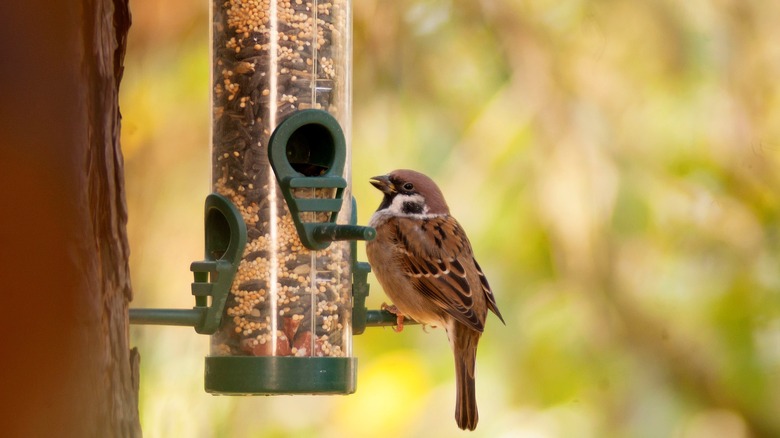
Misha Zlatarov/Shutterstock
Birds love birdfeeders because they are easy ways to grab food. Instead of foraging for it, the seeds or nectar they need to survive are more easily accessible. Using different bird feeders and seeds for different birds is a great way to accommodate their different diets. Birds have all sorts of preferences when it comes to food, like seeds, nectar, insects, fruits, or even meat. If you want a lot of different birds in your yard, it’s important to have a variety of feeders and foods. For example, finches love tube feeders with sunflower seeds, and hummingbirds are drawn to nectar feeders. With lots of options, you’ll have a wide range of birds visiting your yard.
When installing birdfeeders, it’s best to place them near bushes or trees so the birds have somewhere to hide if any predators show up. You should also place them far enough away from your windows so birds don’t get confused and fly straight into the glass. Feeders should be placed 30 feet away from any windows, or within 3 feet of a window. Keeping them 30 feet away will prevent the birds from getting confused. If you have a small yard, placing the feeder within 3 feet of a window ensures that even if a bird does get confused, they can’t build up enough speed to hurt themselves if they bump into the glass. When purchasing feeders, look for ones that won’t spill any seeds or make a mess, because that just attracts pests like squirrels and insects. You can also get feeders that keep out bigger birds and squirrels by using special gadgets like baffles to keep out animals that are not meant to be there.


